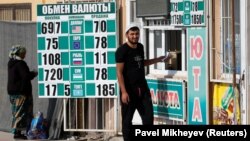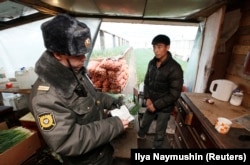BISHKEK -- Despite its share of bustling markets, luxury cars, fancy shopping malls, and other signs of a thriving consumer society, the forecasted per-capita income for Kyrgyzstan this year of some $1,300 is one of the lowest in Central Asia.
And just as the economy of this mountainous country of around 6 million people was recovering from the coronavirus pandemic, Russia’s invasion of Ukraine on February 24 resulted in a Western-led group of countries imposing the toughest sanctions ever on a major economy.
Those restrictions have severely damaged the Russian economy and had adverse effects on Kyrgyzstan and the other Central Asian countries that are so dependent on Russia for goods, jobs, and investment.
Though the sanctions are theoretically reversible, Russia seems for at least the medium term to have lost what was viewed as a captive market.
Russia officially forecasts an economic decline of 8 percent this year, but most other estimates point to a reduction in gross domestic product (GDP) of between 10 and 20 percent.
Currency Woes
The ruble, which took a big hit after the sanctions were announced, fell to an all-time low of 135 to the dollar two weeks after the Russian invasion and was even less valuable than the Kyrgyz som.
But it recovered after the Russian Central Bank rushed through a raft of measures to support it and by May 5 it had strengthened to 65 rubles to the dollar -- its strongest rate in more than a year.
The Central Asian currencies almost always move in lockstep with Russia’s currency, so it was no surprise most of their values dropped with the ruble initially.
Though the ruble is currently holding steady, it is worth noting that, after Russia’s illegal annexation of Ukraine’s Crimean Peninsula in 2014, Western-led sanctions against Moscow and a drop in oil prices resulted in the ruble losing about 30 percent of its value.
Central banks cannot support a currency indefinitely when there is too much downward pressure on it. The bank would exhaust all of its reserves and must eventually let the currency fall.
Inflation And Shortages
As the nominal value of wages and salaries is likely to remain static in Kyrgyzstan, purchasing power will fall as prices increase. The International Monetary Fund (IMF) projects consumer prices in Kyrgyzstan to rise by 13.2 percent this year and by 10.1 percent in 2023.
Russia’s economic problems due to its invasion of Ukraine immediately led to inflation and shortages of many products in Kyrgyzstan.
Some imported medicines doubled in price or were scarce, and food prices shot up.
Most paper in Kyrgyzstan is imported from Russia, which gets its whitener from Europe, leading to a twofold increase in the price of regular copy and printing paper.
Restaurants and cafes in central Bishkek quickly raised their prices by some 10 percent after the sanctions hit Russia and there were reports of less people eating out.
Reduced Remittances
Another closely connected problem to the Russian economy is Kyrgyzstan’s huge dependence on remittances from its migrant workers abroad.
According to official figures, 1.118 million Kyrgyz citizens work abroad, the majority of those in Russia.
That money being sent back to Kyrgyzstan accounts for some 30 percent of the country's GDP -- about $2.5 billion a year.
But remittances in 2022 are expected to drop by some 33 percent compared to the 3 percent rise that was expected before the Russian invasion.
This precipitous decline in remittances as well as a fall in investments due to the war has led the World Bank to forecast Kyrgyzstan’s economy to decline by 5 percent this year.
Kyrgyz migrants who have lost their jobs have even begun returning from Russia, putting further stress on the local economy where joblessness is unofficially estimated to be between 10 and 15 percent.
Not all of those who have returned have stayed in Kyrgyzstan.
One Bishkek taxi driver said some his relatives had gone to Poland and found factory work as the EU became an alternate destination for migrant laborers.
But even migrants with money now have the problem of transferring it back to Kyrgyzstan after the West excluded most Russian banks from the SWIFT messaging network that facilitates international payments.
Transfers were delayed and the exchange rate was lower after sanctions hit Russia.
Furthermore, ATM withdrawals on Russian bank cards no longer worked in many cases. That hit not only Kyrgyz citizens with Russian bank accounts, but also Russians who arrived in Bishkek after the invasion and who -- like their countrymen who moved to Georgia, Turkey, the Baltic states and several other countries -- began having problems accessing their money.
But rich and poor, businesses and individuals, all began seeking alternatives and workarounds, such as routing transfers through banks in third countries. That incurred more bank charges and/or a worse exchange rate, but at least people could get their money.
New Opportunities?
And yet the Western sanctions -- most of them imposed in March -- have barely begun to bite.
Russia can exist on its reserves for a while, but many analysts predict the economic situation in Russia to begin really deteriorating in the coming months.
Despite Russia’s huge importance to Kyrgyzstan and the rest of Central Asia, it is no longer as dominant as it once was, presenting economic opportunities for other countries.
In 2021, Russia was Kyrgyzstan’s biggest trading partner at $2.3 billion in turnover, with China in second place, accounting for $1.53 billion.
And although Kyrgyzstan’s trade with its two main Central Asian partners, Kazakhstan and Uzbekistan, has a total value of $1.56 billion, nearly the same as China, Turkey and “others” account for about $1.86 billion in turnover.
That means Russia accounted for nearly 32 percent of Kyrgyzstan’s total trade of $7.2 billion, far less than it did five or 10 years ago when it constituted the majority of bilateral trade with Bishkek.
Any return to the economic situation that existed in Kyrgyzstan and the rest of Central Asia before the war looks nearly impossible, as the conflict has already resulted in shortages and disruptions of important commodities and exports, such as grain, oil, gas, and metals. And those problems are likely to worsen.
Such conditions will force Kyrgyzstan and the rest of the region to be more entrepreneurial than ever before.


